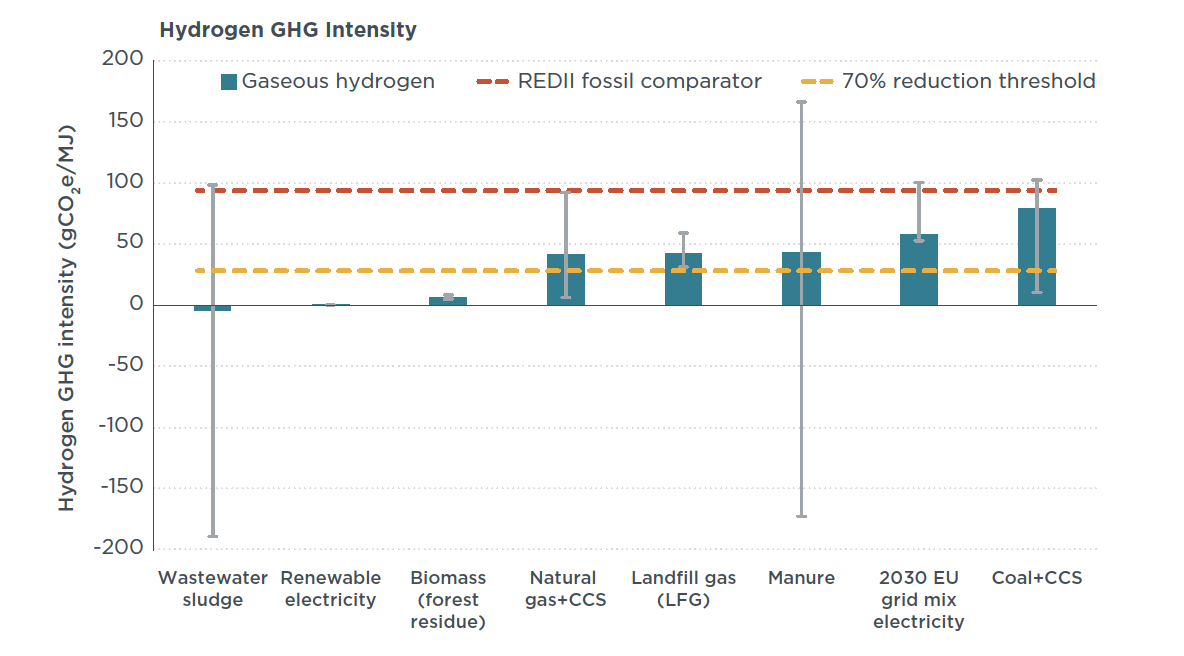This study aims to support European policymakers with a better understanding of the uncertainties regarding gaseous fuels’ roles in meeting EU climate goals. Life-cycle GHG analysis (LCA) is complex, and differences in methodology as well as data inputs and assumptions can spell the difference between a renewable gas pathway qualifying or not for REDII eligibility at the 50% to 80% GHG reduction level. It is thus important for European policymakers to use robust LCA to ensure that policy only supports gas pathways consistent with a vision of deep decarbonization. For this purpose, the study conducts sensitivity analysis of the life-cycle GHG emissions of a number of low-GHG gas pathways, including biomethane produced from four feedstocks: wastewater sludge, manure, landfill gas (LFG), and silage maize; and hydrogen produced from eight sources: natural gas combined with carbon capture and storage (CCS), coal with CCS, biomass gasification, renewable electricity, 2030 EU grid electricity, wastewater sludge biomethane, manure biomethane, and LFG biomethane.
Among the eight hydrogen pathways, hydrogen produced from renewable electricity and forest residue biomass can have low GHG emissions even after accounting for uncertainties in parameters. While hydrogen produced from electrolysis using renewable electricity can reach a close-to-zero GHG intensity, using EU grid electricity results in the high-GHG fuel that may not deliver GHG reductions compared to direct use of fossil fuels. This is a risk if the European Commission does not introduce robust requirements to ensure the use of only additional renewable electricity for hydrogen producers claiming 100% renewable sources in the REDII. Hydrogen produced from biomethane (made from wastewater sludge, LFG, or manure) and natural gas plus CCS can deliver significant GHG reductions, but it is also possible that they could have similar or even higher GHG intensity than the fossil comparator. This is due to the potentially high methane leakage rate during biomethane production or from upstream natural gas extraction and transporting. Fossil-based hydrogen (from natural gas or coal), even with carbon capture, has a very limited role in GHG reduction because current industrial practices only capture 50% of generated carbon dioxide.
Based on the results of this study, we provide several recommendations in two domains: (1) exclusion of certain pathways from use in meeting climate targets and (2) life-cycle methodology for calculating GHG intensity values to determine compliance with legislative mandates. We encourage policymakers not to add fossil-based hydrogen as an eligible pathway in the REDII and not to incentivize this pathway in any other relevant climate and gas policies, such as the upcoming Hydrogen and Decarbonised Gas Market Package. We recommend facility-level measurements on life-cycle GHG, including measurement on methane leakage. We recommend that policymakers provide consistent and detailed guidelines on LCA methodology and data assumptions. Such guidelines are also necessary for the measurement of methane leakage.
SOURCE: ICCT


